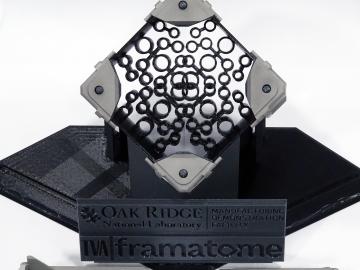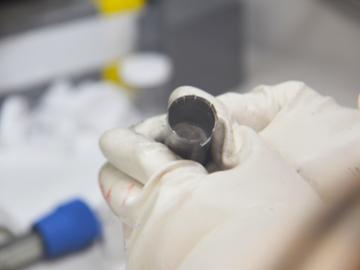
Filter News
Area of Research
- Advanced Manufacturing (1)
- Biology and Environment (17)
- Building Technologies (1)
- Computational Biology (1)
- Computational Engineering (2)
- Computer Science (12)
- Energy Science (21)
- Fusion and Fission (5)
- Fusion Energy (7)
- Materials (14)
- Materials for Computing (6)
- Mathematics (1)
- National Security (14)
- Neutron Science (10)
- Nuclear Science and Technology (12)
- Nuclear Systems Modeling, Simulation and Validation (1)
- Quantum information Science (7)
- Supercomputing (78)
News Type
News Topics
- (-) Advanced Reactors (25)
- (-) Artificial Intelligence (92)
- (-) Computer Science (153)
- (-) Molten Salt (7)
- (-) Quantum Science (59)
- 3-D Printing/Advanced Manufacturing (89)
- Big Data (62)
- Bioenergy (84)
- Biology (100)
- Biomedical (53)
- Biotechnology (28)
- Buildings (50)
- Chemical Sciences (48)
- Clean Water (30)
- Composites (21)
- Coronavirus (30)
- Critical Materials (17)
- Cybersecurity (17)
- Education (2)
- Emergency (4)
- Energy Storage (64)
- Environment (164)
- Exascale Computing (52)
- Fossil Energy (7)
- Frontier (45)
- Fusion (47)
- Grid (54)
- High-Performance Computing (93)
- Hydropower (12)
- Irradiation (2)
- Isotopes (38)
- ITER (7)
- Machine Learning (51)
- Materials (87)
- Materials Science (89)
- Mathematics (11)
- Mercury (10)
- Microelectronics (3)
- Microscopy (34)
- Nanotechnology (29)
- National Security (63)
- Neutron Science (109)
- Nuclear Energy (85)
- Partnerships (37)
- Physics (38)
- Polymers (18)
- Quantum Computing (39)
- Security (17)
- Simulation (51)
- Software (1)
- Space Exploration (23)
- Statistics (3)
- Summit (48)
- Transportation (66)
Media Contacts

To better understand the spread of SARS-CoV-2, the virus that causes COVID-19, Oak Ridge National Laboratory researchers have harnessed the power of supercomputers to accurately model the spike protein that binds the novel coronavirus to a human cell receptor.

The U.S. Air Force and Oak Ridge National Laboratory launched a new high-performance weather forecasting computer system that will provide a platform for some of the most advanced weather modeling in the world.

Since the 1930s, scientists have been using particle accelerators to gain insights into the structure of matter and the laws of physics that govern our world.

Algorithms developed at Oak Ridge National Laboratory can greatly enhance X-ray computed tomography images of 3D-printed metal parts, resulting in more accurate, faster scans.

A multi-institutional team, led by a group of investigators at Oak Ridge National Laboratory, has been studying various SARS-CoV-2 protein targets, including the virus’s main protease. The feat has earned the team a finalist nomination for the Association of Computing Machinery, or ACM, Gordon Bell Special Prize for High Performance Computing-Based COVID-19 Research.

ORNL and three partnering institutions have received $4.2 million over three years to apply artificial intelligence to the advancement of complex systems in which human decision making could be enhanced via technology.

Scientists from Oak Ridge National Laboratory used high-performance computing to create protein models that helped reveal how the outer membrane is tethered to the cell membrane in certain bacteria.

There are more than 17 million veterans in the United States, and approximately half rely on the Department of Veterans Affairs for their healthcare.

The Transformational Challenge Reactor, or TCR, a microreactor built using 3D printing and other new advanced technologies, could be operational by 2024.

Irradiation may slow corrosion of alloys in molten salt, a team of Oak Ridge National Laboratory scientists has found in preliminary tests.


